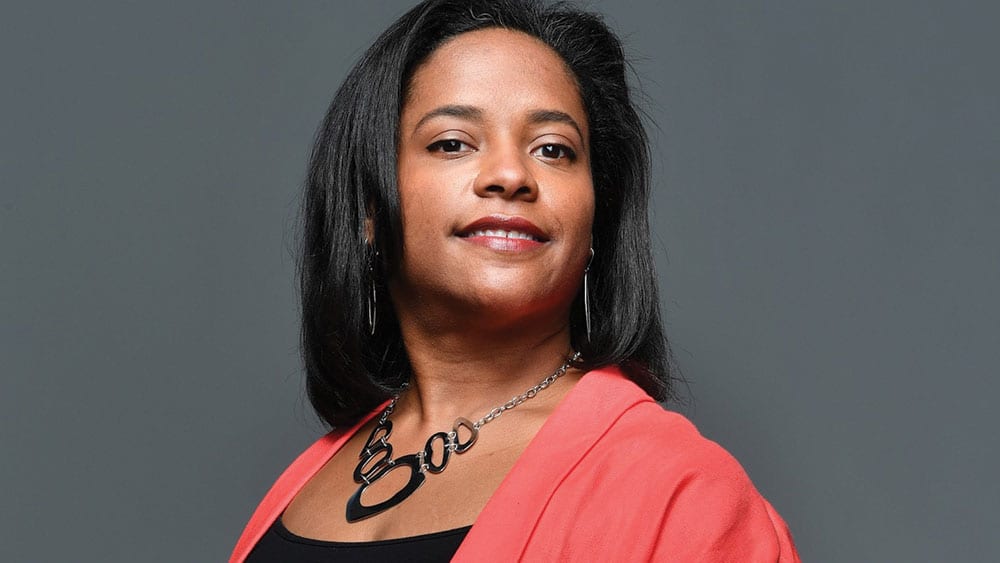Museum curator Tuliza Fleming’s earliest memories take place at the Smithsonian Institution with her parents, which ignited in her a lifelong fascination with history. Her father was a ground-breaking museum director who led the development of the National Afro-American Museum and Cultural Center in Wilberforce, Ohio. He left big shoes for her to fill, but Tuliza certainly rose to the occasion. On her quest to become a museum curator, she earned her M.A. and Ph.D. in American Art History from the University of Maryland, under the tutelage of the late David C. Driskell. Life came full circle for Tuliza, who now acts as the Interim Chief Curator of Visual Arts at the National Museum of African American History and Culture (NMAAHC) of the Smithsonian Institution, where she successfully built the museum’s foundational American art collection.
You attended college in Atlanta. What was that like?
It was one of the best experiences of my life. As a senior in high school, I visited a variety of northeastern schools. However, my visit to Spelman College, a historically black liberal arts school, made the greatest impression. During my time there, I sat in on a class where the professor discussed the famous educator, Booker T. Washington. I had never experienced a class like that before, where the history of African Americans was the primary subject of the class. There was this idea of comradery, learning more about the black experience. I had attended private schools prior to this, but it was different. At Spelman, you were able to take leadership roles. It wasn’t about sexism or racism. If you got a bad grade, you earned that bad grade. If you didn’t get along with the professor, it wasn’t because you were black. You could have any leadership position on campus and being a woman made no difference. It was really a lovely experience.
Do you remember your first seven years being raised in Washington D.C?
I have plenty of recollections. I was a very precocious child. My parents took me to the Smithsonian Institution at a very young age, and some of my earliest memories stem from those visits. I remember being fascinated by the Foucault pendulum at the American History Museum. I remember the elephant at the National Museum of Natural History and going to the National Zoo. I recall always looking at these small statues of stylized women with canonically shaped breasts at National Museum of African Art. Years later, when I started working on my PhD, I minored in Yoruba art. It was at that time I discovered that the sculptures I loved as a child were Yoruba Ibeji twin figures, which are carved to honor and memorialize twins when they pass away. I loved going to the Smithsonian. I also remember the time I spent at Howard University. I was almost raised on Howard’s campus, as both of my parents went there for graduate school. My mother would take me there and I would attend dance classes while she was in class. These are some of my earliest memories, and it is like going home when I step on Howard’s campus.
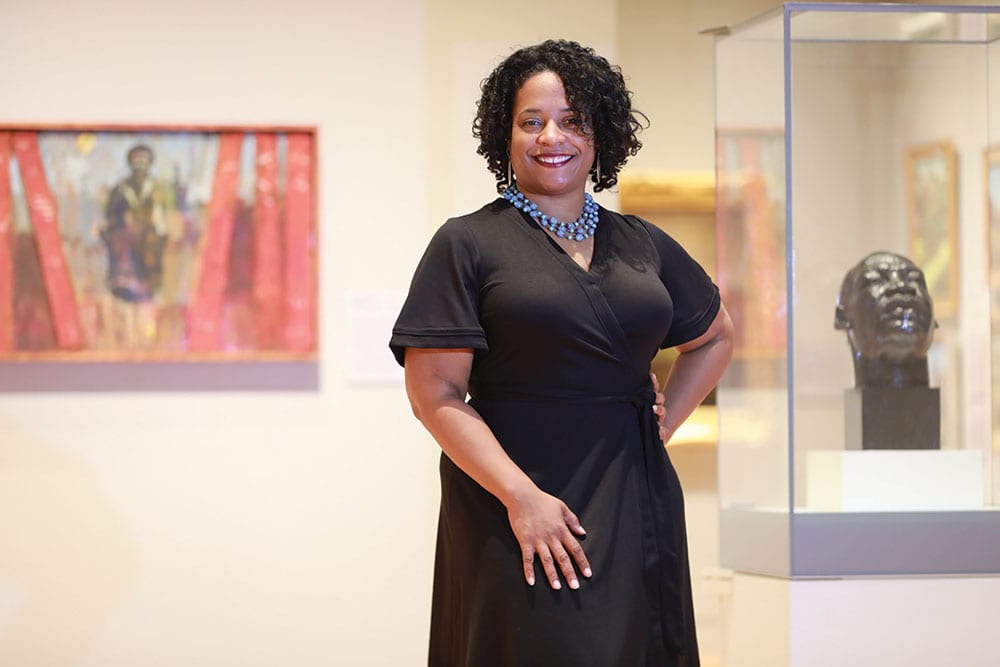
What was it like growing up with a formidable influencer like your father?
We didn’t see it that way. He was just dad. He could be silly, he would play with me, he liked to cook, he would take us on picnics, and he loved flying kites with me and my sister at the park. As you know, in addition to being my father, he was also a ground-breaking museum director. My sister and I always had to go to museum openings. We went to all the events at the museum, which we sometimes resented. I never really thought of him as someone important. He was just my father who punished us when we did something bad and rewarded us when we did something good. His career was not foremost in our minds, except for having to go to history events all the time. Every time we went on vacation, we had to do things like visit historic plantations or go to a museum which, you can imagine, children don’t generally love to do.
Who has influenced you the most professionally?
There were so many people that helped me during my career, but two women really gave me the courage to become a museum curator. When I was working as a summer intern at the National Afro-American Museum and Cultural Center in Wilberforce, Ohio, a woman named June Powell, who worked in the Education Department, gave me some sage advice. At that time, I was waffling between majoring in law and art. I told her that I was scared to make the decision to major in art. She said to me, “If you give a hundred and fifty percent, then you will always be okay because most people do enough just to get by.” The other person was Varnette Honeywood, who I got to know while she was an Artist in Residence at Spelman College. She is probably best remembered for her collaboration with Bill Cosby on the characters for the Nick Jr. children’s television series, Little Bill. I would go to her on-campus residence to chat and hang out. She would give me art supplies and talk to me about being an artist. She also encouraged me when I changed my major. I was an art studio and art history major, and planned to be an artist as well as a curator. She said, “If you go into art history, you’ll never really do art again.” I didn’t believe her, but it was true.
You have mentioned Bill Cosby. He notably impacted our world. What happened? Do you think that the world changed and people like Mr. Cosby did not change with it?
In what way?
The “norm” of the ‘50s, ‘60s, ‘70s are drastically different from today where women are self-actualized. Not to mention the fact that the MeToo Movement came into its own. What was considered acceptable and unacceptable has changed, particularly in terms of men’s treatment of women.
I think the world always changes. The way that society operates changes throughout history. For example, the Roman Empire. People would fight in the coliseum sometimes to the death. We would never do that now. That is not acceptable. Wars have changed. People’s value on human life has really shifted including women’s rights. So, now we talk about the MeToo Movement. But think about the fact that in the 19th century, when a woman married, she and her children became the property of her husband. The woman’s money became her husband’s property. That wasn’t that long ago. If the domestic situation went badly, and the woman wanted to leave, she would be forced to leave everything behind. In some cultures, even today, the woman cannot go back home to her family if she decides to divorce. I think what we’re experiencing now is just another level of societal change, and it goes back and forth over time. That is what history is, right? You relive certain things. Human behavior might shift, but sometimes things unfortunately stay the same.
Your first “paying job” was an internship. You have been quoted saying that internships have “served you very well.” Why?
I encourage all students that I meet or people who want to go into the museum world to participate in an internship program. I interned at a variety of different areas in the museum, and it really helped me decide what I wanted to do. I think this is true of other careers as well. By way of example, many people study law but the experience of becoming a lawyer is very different. If a person decides to specialize in corporate law, they might be surprised how different corporate culture is from the experience of attending law school at a University. It’s the same thing for the art history. Education alone does not prepare you to become a curator. The museum field is difficult to break into, and curatorial positions are very competitive. Interning gives you insight into the field and teaches you how to become a museum professional. My experience of interning in history and art museums has been invaluable. Of course, not all of them were exciting. I remember doing an internship where I sat in front of the Xerox machine all day long, filing and doing other clerical duties, but on the whole, those experiences really helped me decide what I wanted to do.
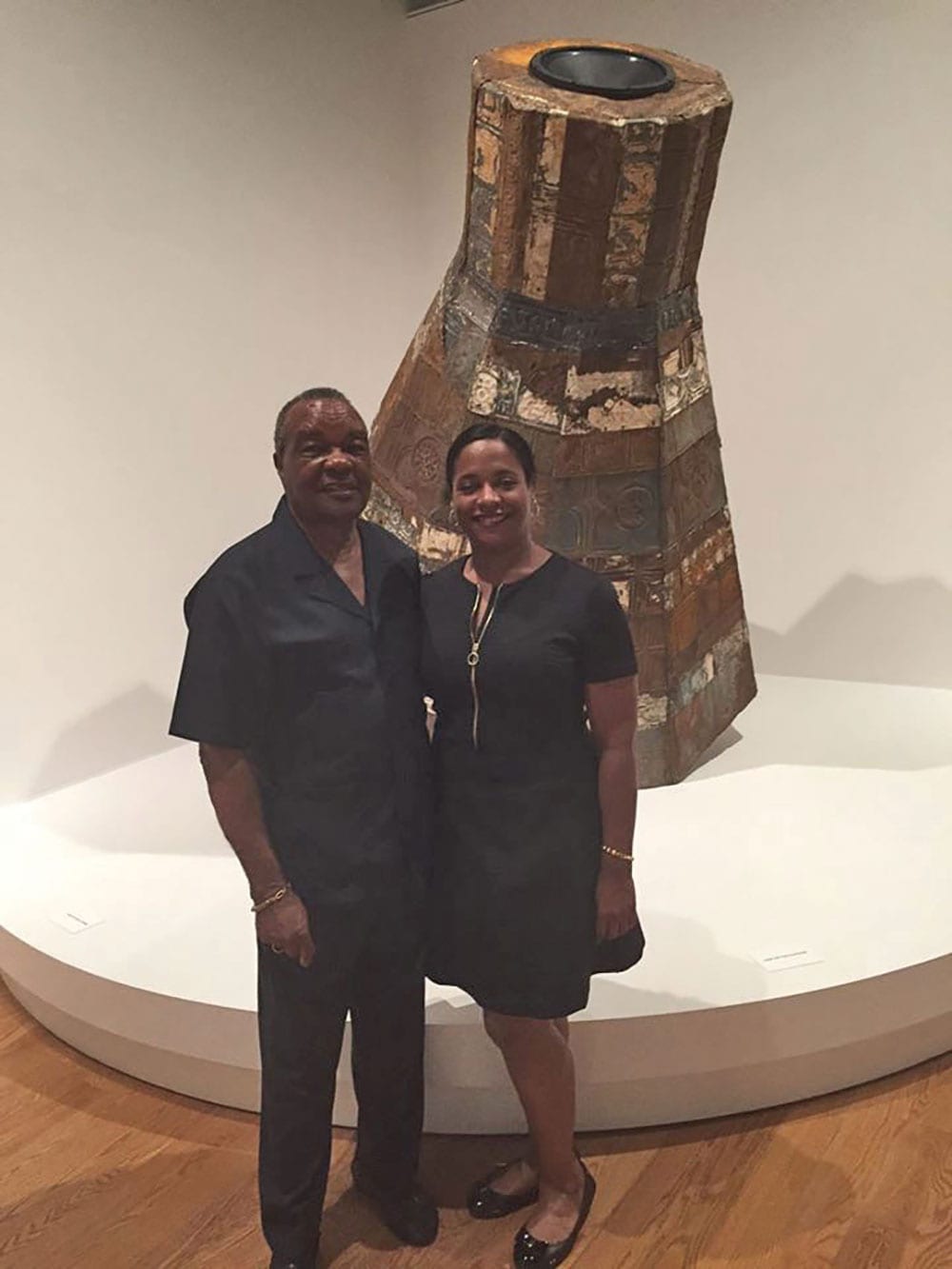
David C. Driskell and Tuliza in the Visual Art and the American Experience Gallery. 2007.
A Master’s Degree and a PhD from the University of Maryland. David C. Driskell was your mentor?
Yes, we are very close. The first time I met him was when I was a student at Spelman College. I attended a lecture that he gave. We watched a BBC documentary that featured him and his career, and then he talked about it afterwards. He was an artist, an art historian, a professor and a curator. I was blown away. I wanted to be just like him. I went to the head of my department afterwards, and I asked, “Where is he? Where does he work?” The director told me he worked at the University of Maryland. That’s why I applied to the University of Maryland for graduate school.
What did he say that resonated or connected to you?
I don’t recall what he said. I think it was his demeanor. I think it was the fact that he did this really famous exhibition that changed the way museums viewed and interpreted artwork by African Americans.
Did you enjoy your time at the University of Maryland?
It was a little tough coming from a small predominately black women’s college. Being one of the few African Americans in the University of Maryland’s PhD program for American art history took a bit of getting used to. I was very young, maybe 20, when I enrolled. It was a real adjustment coming from a very supportive college community that was insulated from
racism and sexism to the real world, where not everyone was invested in your success. Many people were very supportive, but I think that there was a bit of a culture shock for me. However, I made it through. I’m still friends with many of my former classmates and professors to this day.
From the University of Maryland, where do you go?
The Dayton Art Institute. Well, initially, I went home because I was studying for my oral exams and I ran out of money. I remember trying to get a job at a temp agency. I was grossly unqualified to do anything but Microsoft Word, so I was not hired. The only place that was willing to hire me was Macy’s, as a salesperson. Luckily, I also went to the Dayton Art Institute just to see what positions they had available. In those days, they only had one page on the website that listed the hours of operation and had a picture of the museum. So, I went to the museum in person and explained to the two ladies at the information desk that I had a master’s degree and was ABD, (which means all but dissertation), and that I was interested in a position at the museum. They told me that the cafeteria may be hiring, which I found very disappointing and dismissive. So, I left, and then I called HR where I learned they did have a position open for assistant curator of American Art. I applied for that job. It was a rigorous interview process, and despite the fact that I was naïve, the interview went well. I remember the director, Alex Nyerges, asking if there was anything I would change. I suggested that the museum should collect and display more work by African American artists because even though the Dayton population was about 40-45 percent black at the time, very few artists of color were represented in the museum. I also told him about my experience with the information desk. I explained that a lot of African Americans feel uncomfortable going into predominantly white art institutions because of negative experiences such as mine. I suggested that this needed to be worked on. Thankfully, that institution has changed. We had the most diverse curatorial staff in the country at that time. Alex really took a chance in hiring me to oversee the American Art Department. I was in my late 20s at the time and probably looked like I was about 21. I think that the combination of my race and my age took people by surprise. It was a wonderful opportunity, and I think the experience gave me the necessary skills to succeed at the Smithsonian.
Life is a series of circles . . . The Dayton Art Institute prepared you for your work at the Smithsonian. Your father was also instrumental in the US Congress passing the enabling legislation which set aside major funding for this museum, many years prior. How did the circle close?
Yes, it goes back to my father, who was appointed by President George W. Bush to the Presidential Commission of the National Museum of African American History and Culture Plan for Action. Although I did not know of his official involvement in the project at that time, I remember my father being really interested in having this museum be a part of the Smithsonian museum and feeling strongly that it should be located on the Mall. There were town hall meetings about the museum project held across the country, and people were invited to share their input and vision for this institution. I attended two town hall meetings. What really impressed me was how passionate and meaningful the creation of this museum was to the general public, and for African Americans in particular. It’s very hard to explain, but the meetings served as a catalyst for my future career goals. Just watching people at the microphone talk about what they wanted for this museum, what this museum would mean to them, made me want to be a part of that vision. I followed the museum’s process and progress. One day, one of my classmates from the University of Maryland said that they were advertising a job. The application submission was almost closed when I found out. I said, “I don’t know, I don’t know, I don’t know,” but I applied anyway. At that time, we didn’t have electronic applications. I wrote my letter and faxed in my resume, and then I got a call back. I interviewed with Lonnie Bunch, with the chief curator, Jacquelyn Serwer, and with the deputy director, Kinshasha Holman Conwill, among others. After a series of personal interviews and phone interviews, I was offered the job.
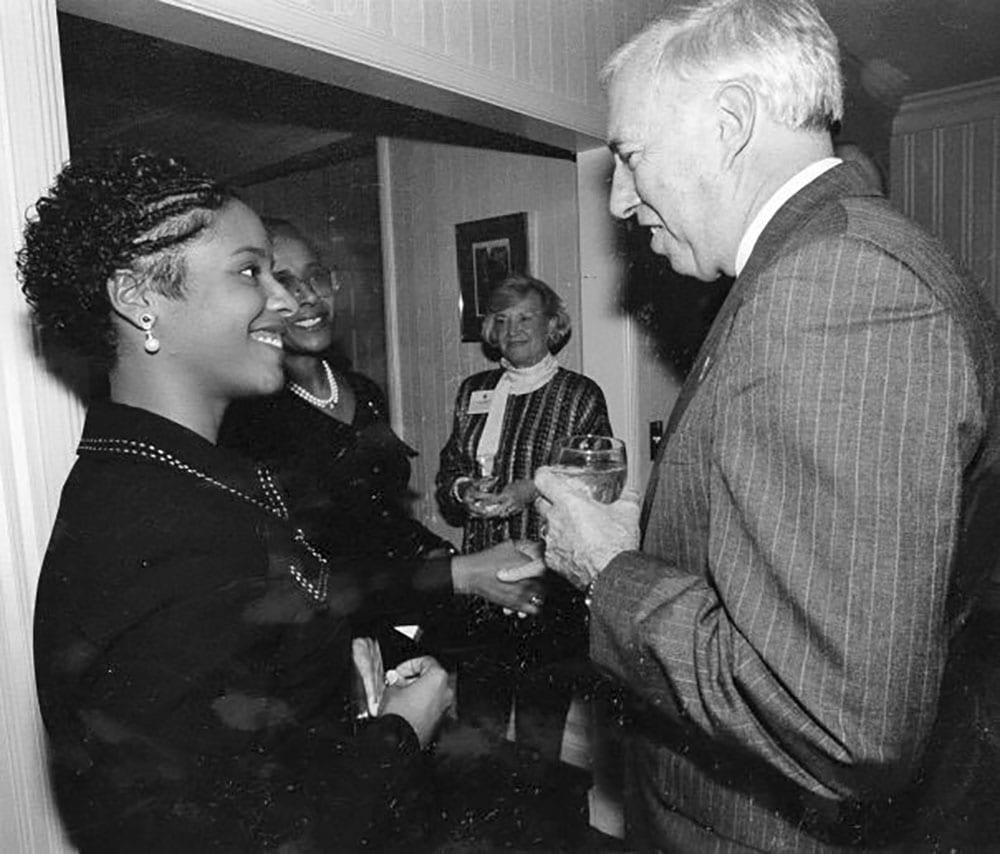
Tuliza Fleming and Clayton Daniel Mote Jr. (former President of the University of Maryland, College Park) at David C. Driskell’s retirement party at Driskell’s home in Hyattsville, MD. Standing next to Tuliza is her mother, Dr. Barbara Fleming. 1998
What do you enjoy the most about your position as the Curator of American Art at the National Museum of African American History and Culture (NMAAHC) at the Smithsonian Institution? What has been the biggest challenge?
I am very blessed because I love every aspect of my job. I love researching, writing and curating. I mastered those skills before I took the position because I completed a number of exhibitions at my prior institution. What I did not learn at Dayton Art Institute, since it had a very good and well-established art collection, was to cultivate donors who collected art by African Americans. Building a donor base from scratch has been the most challenging aspect of my career here. My previous work at predominately white art institutions with collections that mostly featured white male artists did not prepare me for the challenge of building this collection. I did not know very many people who were collectors of work by African Americans. Consequently, when I started here, I didn’t have a roster of donors. It was very challenging. We were asked to amass a collection of art created by African Americans from the turn of the 18th Century to the present. I slowly began to meet people who collected. I learned that people who collect art know other people who collect art and they would introduce me to their colleagues. It is a specialized area of interest. I would come into their homes and explain to them how we planned to exhibit art and how our museum was going to interpret it differently, even though we were not an art museum. I then gave them our perspective. I explained that we would not talk about race unless it was germane to the artwork or important to the artist. That was an important point for most collectors as many of them were weary of the way most art museums racialized work by black artists, regardless of the subject or style. I was very enthusiastic about the museum because most people don’t expect an art gallery to be in a museum of history and culture. People didn’t know what to think, but they believed in the museum and they believed in our vision for the art gallery.
Is the differentiator that the artwork (and therefore artist) is seen foremost as creating American Art . . . which is exhibited in the National Museum of African American History and Culture (NMAAHC)?
Yes. It has always been important to define art by black artists as American art, as opposed to “black art.” Far too often, when African American artists were featured in an exhibition, the descriptor label would identify that artist as black. Conversely, when work by white artists were exhibited, the race of the artist was never mentioned. These types of classifications based on race bothered and continues to bother many artists because they wanted to be evaluated on the merits of their artwork, as they should be. They are American citizens. African Americans have been in this country longer than most Americans and in many ways our history and our struggles define what it means to be an American. When I spoke to these collectors, it was what they wanted to hear, and they would allow me to choose the work for the gallery.
How do you select art?
We had an outline of the types of works we needed to fulfill our narrative for the inaugural art exhibition, Visual Art and the American Experience. If we weren’t able to purchase the work, I worked with donors to assist us with filling in the gaps. I met one collector who told me that he heard that I was the curator who, “tells people what they’re going to donate and does not accept what you want to give.” I explained it was true and that we never wanted to acquire art from someone’s home that we really didn’t feel was right for us, and then I proceeded to tell him the artwork that I hoped that he would give. After much time and deliberation, he did donate the piece that I thought was best for our museum, a Parisian landscape by Lois Mailou Jones.
What makes a collection and exhibit successful?
Having great passion for this museum and a strong mission is important. Working with donors who support this museum is critical to the growth of our collection. Our collectors are not shy about calling other collectors. In terms of what makes a collection great depends on the goals of the museum. For example, our goal was to create a representative sweep of the depth and breadth of art by African Americans over time. We also wanted to lift up the profile artists who have been ignored by the greater art world due to racism and segregation. Additionally, we wanted to align our collection strategy with the goals and objectives found in other areas of the museum. That is our museum. Other institutions have their own mission and ways through which their collection strategy and exhibition style is determined. If the viewer and the staff of the museum both feel that those objectives have been met, then for me, that makes the collection and exhibition successful.
Can you describe the job of the Curator of American Art?
The curator is responsible for overseeing the collection, purchasing artwork, working with donors, researching the collection, selecting art for exhibition, developing an exhibition narrative. Interpreting the artwork via label and wall text is the curator’s responsibility as well. A great curator, in my opinion, is someone who can create an exhibition where expert and novice alike can visit and leave saying that they learned or saw something new and interesting. It is someone who can make the specific universal and convey a sense of relevancy to the visitor, no matter the subject or field of the exhibition.
What’s your greatest accomplishment to date and why?
My greatest accomplishment is being part of this museum . . . to build a collection when we did not have a collection and to be part of this. While I always knew it was an important museum, I never knew it was going to be so important until I saw the public’s reaction and the fact so many people are now exposed to the arts. I was able to start with very little and create a vision, my vision, in a Smithsonian Institution. Who cannot be proud of that?
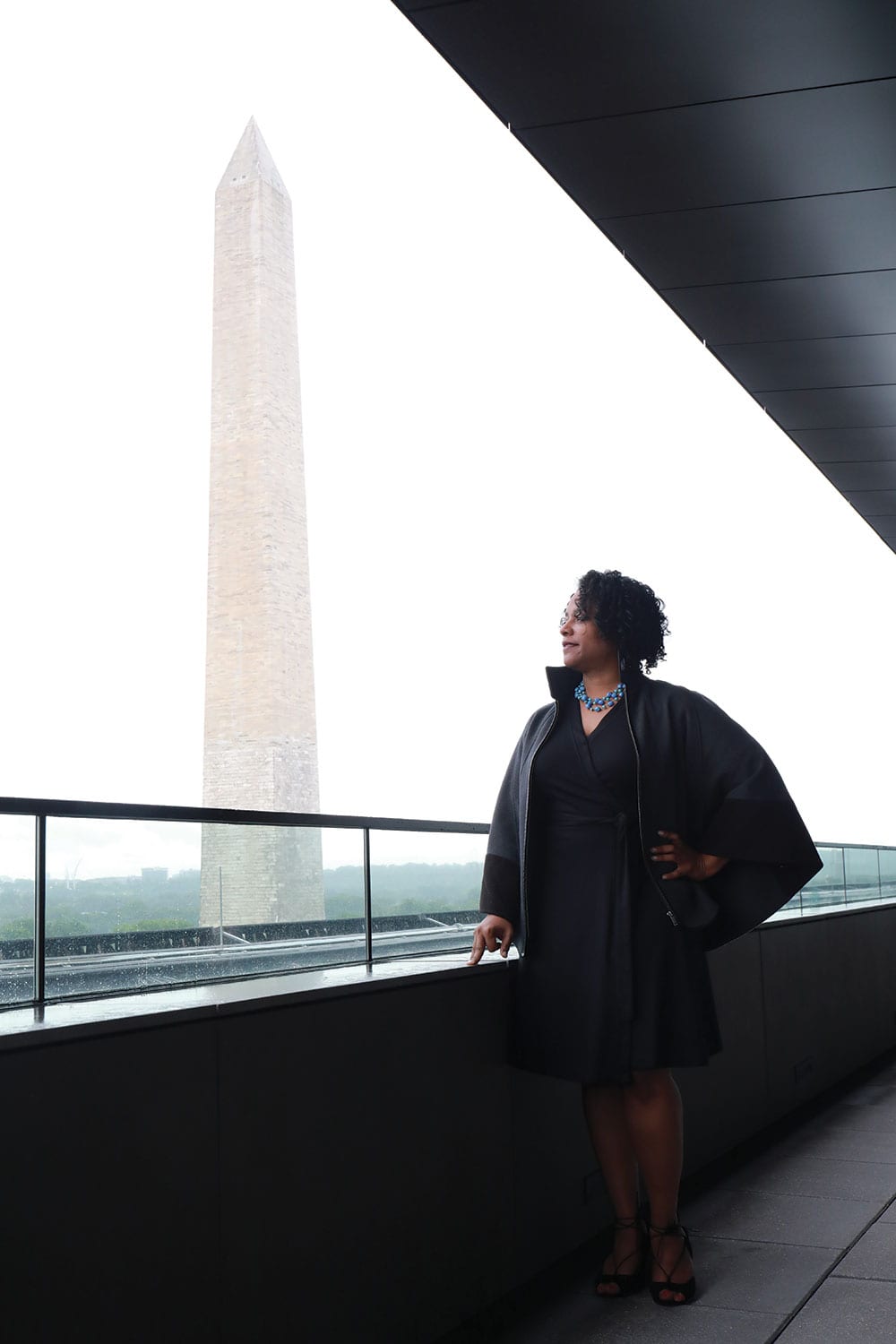
Tuliza looking out towards the Washington Monument from the NMAAHC, where she holds the position of Interim Chief Curator of Visual Arts.
What has been the most difficult thing for you to overcome to stay on your career trajectory?
I suppose it was the fear of investing so much time and money into my education and not being able to make a decent living once I entered the job market. I remember being tired and “burnt out” in grad school when I read an article about compensation for certain jobs in New York City. It was the 1990s, and I remember seeing that in New York, an administrative assistant to a CEO of a major corporation could make upwards of $100,000 a year and a manager at Burger King could make $57,000. I was killing myself to get a PhD and going into debt for the chance that, if hired, I could earn the average curatorial salary of $45,000. When I read that, I seriously considered throwing in the towel. I suppose that I told my father about my feelings because not long afterwards, he sent me a handwritten letter telling me why I shouldn’t leave the field.
What was in that letter?
I don’t recall what he said, but I thought it was interesting that he wrote the letter. He had gone through the same thing while he was in school. It was a challenge entering a field where you’re not necessarily wanted, and you’re doing it in an area where there are very few people of color. Knowing that, when people look at you, they assume, with or without malice, that you are not as good or as intelligent as your colleagues or peers. People of color spend their lives having to prove they are good enough. Whereas, if you are a white male, you have to disprove people’s presumptions of excellence. It was difficult for me to move into that space. One of the reasons I did my dissertation on the subject that strongly intersected with the history field, in addition to art history, was because I needed to hedge my bets. I never knew if I was going to get a job in an art museum. It made me sad about this field. It was difficult to really make that decision and get through that period of my life.
What piece of advice relating to your life’s journey can you give a young woman?
I tell people never to enter a PhD program without a fellowship because it’s very difficult to pay those student loans back. It costs as much money to be a medical doctor as it costs to be an art historian. You really need to have financial support. I also tell people not to go into the field unless you love it. If there’s anything else you can do that you can love as much, don’t go into this field. But, if you can’t do anything else, then this is the field for you. I cannot imagine doing anything else, and most people who are in the field can’t imagine that either. You have to have a passion for it and not because it’s cool or you’ve seen somebody on television who is an art dealer. It is a difficult field to enter, to find a job and to live on the salary. People do this work because they love it, and that’s the only reason to do it.
Is that a metaphor for life? Only do things if you love them?
No. Some people have responsibilities which make them do things they are not passionate about. I think that the idea that people should pursue their dreams is false. If you have children, you might have to pursue a career that you don’t love. You can’t do everything that you love, but I think you should have something that you do in your life that you love.

